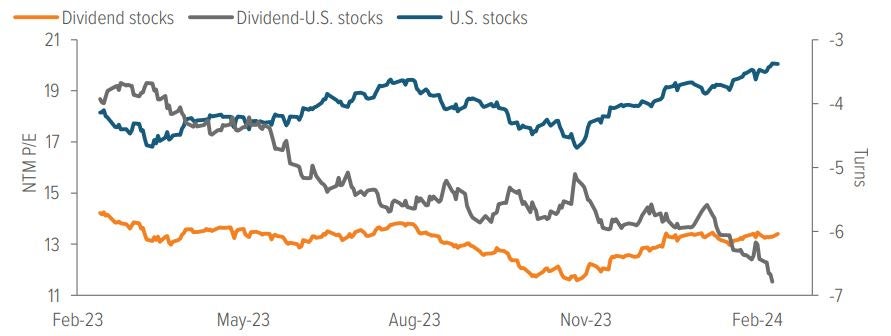
Key Takeaways
Dividend-paying stocks are trading at a steep discount to the broader market at a time when the turn in the interest-rate cycle could make dividends more appealing.
A return to dividend payers’ previous market multiple would translate to outperformance over the market of about 20% (Exhibit 1).
Our “excess capital yield” framework shows dividends are poised to drive future earnings and generate alpha for investors.
We believe a lower interest rate regime will propel dividend-paying stocks, which may offer as much as 2000 basis points of upside relative to the rest of the market, based on historical valuations.
The connection between dividend payers and interest rates
Dividend-yielding stocks are closely tied to the movement of interest rates in two primary ways. First, these stocks are often found in high-debt industries such as utilities and telecoms. When interest rates rise, debt costs increase, putting pressure on earnings and subsequently causing stock prices to decline.

As of 01/03/24. Source: Bloomberg, 22V Research. The gray line represents the forward price-to-earnings multiple of a sustainable-yield basket of stocks. The blue line represents the S&P 1500 Composite Index (less the “magnificent seven” stocks of Apple, Nvidia, Alphabet, Meta, Microsoft, Tesla and Amazon to remove their distortion effect.) The 20% relative outperformance is calculated by the current sustainable-yield basket’s 13x multiple increased by the difference of 5–6 and 2.5–3 turns, which equates to roughly 20% relative upside to the broad market.
Second, high interest rates attract investors to other income-generating assets, particularly those that are short term and perceived as safe. For instance, during the Federal Reserve’s 11 consecutive rate hikes from March 2022 to July 2023, the yield on the 10-year Treasury rose from 1.72% to 3.97% and eventually peaked at 5.00% in October 2023.1 Money market funds saw a 21% increase in assets over the same period,2 as investors flocked to high-yielding cash equivalents, often at the expense of dividend stocks, which pressured valuations.
An emerging opportunity
If interest rates decline and stabilize in a lower range this year as the market expects, yields on short term instruments will also fall, and investors may once again turn to dividend-yielding stocks for income, relieving the pressure on valuations and potentially boosting market prices.
We believe this shift could reverse the underperformance of dividend stocks over the past 18 months. If dividend-yielding stocks were to regain the same relative P/E multiple they carried at the end of 2022, it would represent potential outperformance of as much as 2000 basis points relative to the broad U.S. equity market (Exhibit 1).
In addition, dividend payers have historically acted as a hedge against market uncertainty since company managements are reluctant to change payout ratios. This stability could become even more appealing in a year of elevated economic and political uncertainty.
Flexibility in alpha generation
Dividend yield, on its own, doesn’t tell you much about a stock’s potential, just as a low book-to-price ratio isn’t the sole measure of value. At Voya, we take a flexible and dynamic approach to value investing that looks for companies that generate excess capital.
This framework effectively detects levers from a company’s balance sheet, sales, margins and earnings power that drive shareholder value, while fundamental analyses assess the company’s capacity to convert excess capital into favorable shareholder returns. This comprehensive approach gauges the company’s potential to generate future value through dividend growth, share repurchases, accretive mergers and acquisitions, and organic investments.
Today, our “excess capital yield” framework considers dividend payers’ compelling near-term valuations as well as other relative valuation measures and qualitative, differentiated insights. This dynamic approach enables us to construct diversified portfolios aimed at generating long-term alpha.


